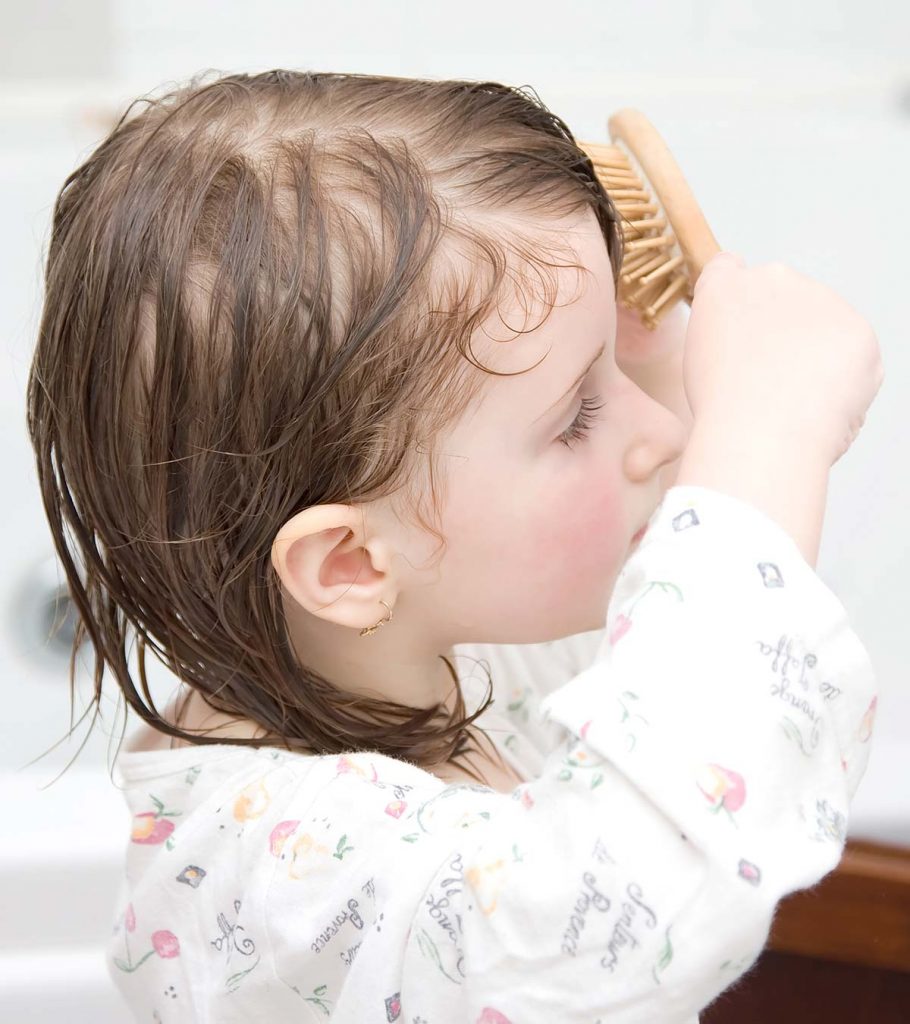Although rare, it is possible to see dandruff in toddlers. Dandruff is flaking of the scalp that leads to a formation of yellow or white flakes that are visible on the toddler’s head, hair, and shoulders. The toddlers may also exhibit signs such as scratching their heads and may complain of an itchy scalp (1) (2). Toddler dandruff may also indicate a probability of seborrheic dermatitis. Continue reading this post as we tell you the causes, symptoms, home remedies, and dandruff treatment in toddlers.
Symptoms Of Dandruff In Toddlers
The primary symptom is the formation of yellow or white dandruff flakes, which are often visible on the scalp and shoulders. Severe dandruff problems can be due to seborrheic dermatitis, which can display the following symptoms (3).
- A red rash around the ear, forehead, eyebrow, or the scalp
- Greasy white or yellow scales of skin that can be accompanied by red patches of skin seen along the hairline, behind the hair, on eyebrows, on the bridge of the nose, between nose and lips, on the chest, on underarms and groin
- Dryness of skin
- Temporary hair loss
- Itchiness
If the dandruff is caused by a fungal infection or yeast overgrowth, then you will notice the loss of hair or hairless patches on the scalp.
A study examined the prevalence of Seborrheic Dermatitis (SD) among different age groups, and the graph below presents its findings. The study results show that SD affects children between one and four years of age, and the condition is slightly more prevalent in boys than girls of the same age group.
Prevalence of seborrheic dermatitis in children by age and sex (2019)
Source: The global, regional, and national burden of seborrheic dermatitis: results and insights from the Global Burden of Disease 2019 Study; Archives of Dermatological Research
Causes Of Dandruff In Toddlers
The exact cause of dandruff is unknown (4). The following conditions or problems can increase the possibility of dandruff (4) (5) (6) (7).
- Oily skin
- Fungal infections, like those caused by a fungus called Malassezia .
- Seasonal changes; dandruff is seen more during winters due to increased oil production and moist scalp .
- Some researchers say that dandruff has a genetic predisposition .
- Allergic reaction to some chemical irritants in soap or shampoo.
- Eczema, According to the Centers for Disease Control and Prevention (CDC), about 10.4% of children in the US aged between zero to five years suffered from eczema, characterized by shedding of skin and thus increased formation of dandruff flakes.
Parents can consider using home remedies to get relief from dandruff.
Home Remedies For Dandruff in Toddlers
The following home remedies have been in use among adults. However, their efficiency in toddlers is not completely known. So, consult a doctor before using any of these natural remedies for toddlers.
- Lemon juice diluted in water is said to be effective in clearing dandruff (8).
- The pulp of aloe vera has been found to be an effective mild cleanser in treating dandruff and itchiness of scalp (8).
- Overnight application of olive oil to moisturize the scalp, has been found useful for reducing dandruff (8).
- Massaging coconut oil on hair and scalp before shampoo is also considered effective (8). Virgin coconut oil has both antibacterial and antifungal properties (9).
- Shampoo containing tea tree oil is found to be effective in treating dandruff (10).
- A paste made from holy basil or papaya and yogurt also helps in treating dandruff (9).
- A combination of egg yolks, honey, and yogurt can nourish the scalp (9)
- Hair products containing lavender and rosemary can help in gentle cleansing (9)
- Shampoos containing ginger have been found effective in reducing dandruff (11).
- Rinsing of hair with boiled and cooled neem leaf water has shown a reduction of dandruff owing to neem’s antibacterial and antifungal properties (12).
- Application of a diluted paste of baking soda for a few minutes before shampooing helps in the reduction of dandruff. Baking soda has mild exfoliation properties. It absorbs excess oil, removes dead cells, and also fights fungal infections (12).
- Lemongrass oil was seen to be effective in treating dandruff (13).
If your toddler has any allergy, then never use any home remedies without first consulting a pediatrician.
When To Visit The Doctor?
Dandruff usually gets better by using mild baby shampoos, medicated shampoos, or by some home remedies in a few days. However, if you notice the following conditions, then see a doctor.
- Dandruff gets worse with increased flaking
- Severe itchiness
- Hair Fall or loss of hair in patches
- Bleeding or formation of pus on the scalp
How To Treat Dandruff In Toddlers?
The doctor might recommend anti-dandruff shampoos or ointments that help in treating dandruff. Recommendations might include:
- Wash your toddler’s scalp and hair regularly for proper hair care.
- Use a clean, soft bristle brush to comb their hair.
- Use of anti-dandruff shampoo.
- If OTC shampoos do not help, then the doctor might recommend a suitable shampoo, steroid cream, or antifungal cream depending on the problem.
- The doctor might recommend a shampoo that contains salicylic acid. Salicylic acid breaks down thick layers of skin and helps reduce dandruff (14).
- Shampoos containing other agents like 1% selenium sulfide, sulfur, tar, zinc pyrithione, or zinc oxide, ketoconazole(2%), etc., are also effective. However, use them only under the doctor’s recommendation (15).
- Limiting the intake of dietary products like bread, cheese, or food that is made with yeast or fungi (16).
Always follow the doctor’s recommendation before using any special shampoo or any other product for the toddler.














